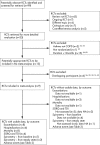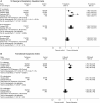Tiotropium for stable chronic obstructive pulmonary disease: A meta-analysis
- PMID: 16844726
- PMCID: PMC2104759
- DOI: 10.1136/thx.2006.063271
Tiotropium for stable chronic obstructive pulmonary disease: A meta-analysis
Erratum in
- Thorax. 2007 Feb;62(2):191
Abstract
Background: A systematic review was undertaken to evaluate the efficacy of tiotropium, a long acting anticholinergic drug, on clinical events, symptom scales, pulmonary function, and adverse events in stable chronic obstructive pulmonary disease (COPD).
Methods: A systematic search was made of the Cochrane trials database, MEDLINE, EMBASE, CINAHL, and a hand search of 20 respiratory journals. Missing data were obtained from authors and the manufacturer. Randomised controlled trials of > or =12 weeks' duration comparing tiotropium with placebo, ipratropium bromide, or long acting beta2 agonists (LABA) were reviewed. Studies were pooled to yield odds ratios (OR) or weighted mean differences with 95% confidence intervals (CI).
Results: Nine trials (8002 patients) met the inclusion criteria. Tiotropium reduced the odds of a COPD exacerbation (OR 0.73; 95% CI 0.66 to 0.81) and related hospitalisation (OR 0.68; 95% CI 0.54 to 0.84) but not pulmonary (OR 0.50; 95% CI 0.19 to 1.29) or all-cause (OR 0.96; 95% CI 0.63 to 1.47) mortality compared with placebo and ipratropium. Reductions in exacerbations and hospitalisations compared with LABA were not statistically significant. Similar patterns were evident for quality of life and symptom scales. Tiotropium yielded greater increases in forced expiratory volume in 1 second (FEV1) and forced vital capacity (FVC) from baseline to 6-12 months than did placebo, ipratropium, and LABA. Decline in FEV1 over 1 year was 30 ml (95% CI 7 to 53) slower with tiotropium than with placebo and ipratropium (data were not available for LABA). Reports of dry mouth and urinary tract infections were increased with tiotropium.
Conclusions: Tiotropium reduced COPD exacerbations and related hospitalisations, improved quality of life and symptoms, and may have slowed the decline in FEV1. Long term trials are warranted to evaluate the effects of tiotropium on decline in FEV1 and to clarify its role compared with LABA.
Conflict of interest statement
Competing interests: Dr Barr: none. Dr Bourbeau has received honoraria for CME, membership on advisory boards and financial support from government agencies, contract and investigator initiated research studies for a number of companies including Altana, Astra Zeneca, Bayer, Boehringer‐Ingelheim, GlaxoSmithKline, Novartis and Pfizer. Dr Camargo has received investigator initiated grants and consulting/lecture honoraria from AstraZeneca, Boehringer‐Ingelheim, GlaxoSmithKline, and Novartis. Dr Ram: none.
References
-
- Murray C J L, Lopez A D. Alternative projections of mortality and disability by cause 1990–2020: Global Burden of Disease Study. Lancet 19973491498–1504. - PubMed
-
- Haddad E, Mak J, Barnes P. Characterization of 3H Ba 679 BR, a slowly dissociation muscarinic antagonist, in human lung: radioligand binding and autoradiographic mapping. Mol Pharmacol 199445899–907. - PubMed
-
- Barnes P J. The pharmacological properties of tiotropium. Chest 2000117(2 Suppl)63–6S. - PubMed
Publication types
MeSH terms
Substances
Grants and funding
LinkOut - more resources
Full Text Sources
Medical
Miscellaneous





